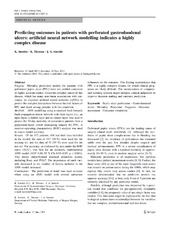| dc.description.abstract | Purpose Mortality prediction models for patients with perforated peptic ulcer (PPU) have not yielded consistent or highly accurate results. Given the complex nature of this disease, which has many non-linear associations with outcomes, we explored artificial neural networks (ANNs) to predict the complex interactions between the risk factors of PPU and death among patients with this condition. Methods ANN modelling using a standard feed-forward, back-propagation neural network with three layers (i.e., an input layer, a hidden layer and an output layer) was used to predict the 30-day mortality of consecutive patients from a population-based cohort undergoing surgery for PPU. A receiver-operating characteristic (ROC) analysis was used to assess model accuracy. Results Of the 172 patients, 168 had their data included in the model; the data of 117 (70 %) were used for the training set, and the data of 51 (39 %) were used for the test set. The accuracy, as evaluated by area under the ROC curve (AUC), was best for an inclusive, multifactorial ANN model (AUC 0.90, 95 % CIs 0.85–0.95; p < 0.001). This model outperformed standard predictive scores, including Boey and PULP. The importance of each variable decreased as the number of factors included in the ANN model increased. Conclusions The prediction of death was most accurate when using an ANN model with several univariate influences on the outcome. This finding demonstrates that PPU is a highly complex disease for which clinical prognoses are likely difficult. The incorporation of computerised learning systems might enhance clinical judgments to improve decision making and outcome prediction. | en_US |

